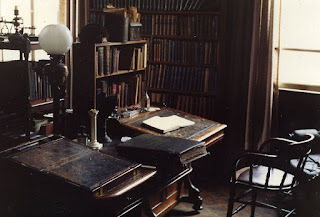Preview: The Composition and Publication of the "Dream of the Gerontius" in 1865
Before Edward Elgar set the text of Newman's Dream of Gerontius to music in 1900, of course, Newman had written that eloquent poem about death, judgment, Heaven, and hell in 1895, 160 years ago this year.

So, since two weeks ago on the Son Rise Morning Show we featured the Elgar anniversary, this coming Monday, September 8, we'll look at the composition and publication of Saint (Doctor) John Henry Newman's poem itself in 1865. (The Son Rise Morning hosts were busy the week before at the EWTN Radio Conference in Washington, DC and took the Monday, September 1 Labor Day holiday off!) I'll be on the air at my usual time around 7:50 a.m. Eastern/6:50 a.m. Central. Please listen live here or catch the podcast later here.
Newman's other most famous poem is "The Pillar of the Cloud", better known as "Lead, Kindly Light". He wrote that poem and many others while he was travelling with his friend Hurrell Froude in Italy and the Mediterranean. He wrote those verses in the Romantic mode as defined by William Wordsworth in the Preface to Lyrical Ballads (1800): as ". . . the spontaneous overflow of powerful feelings: it takes its origin from emotion recollected in tranquillity", reflecting on his experiences on that journey.
Newman wrote this poem, the longest we have of his, on 52 scraps of paper between January 17 and February 7, 1865. There was a sudden inspiration and an urge to write it--and a definite end to the inspiration. One of his biographers, Wilfrid Ward, describes its composition:
Now, after the abandonment of the Oxford scheme [to found an Oratory for Catholic students, who could at last attend Oxford] gave him leisure for it, he set down in dramatic form the vision of a Christian's death on which his imagination had been dwelling. The writing of it was a sudden inspiration, and his work was begun in January and completed in February 1865. "On the 17th of January last," he writes to Mr. Allies in October, "it came into my head to write it, I really can't tell how. And I wrote on till it was finished on small bits of paper, and I could no more write anything else by willing it than I could fly." To another correspondent [The Rev. John Telford, priest at Ryde] also, who was fascinated by the Dream, and longed to have the picture it gave still further filled in, he wrote:"You do me too much honour if you think I am to see in a dream everything that is to be seen in the subject dreamed about. I have said what I saw. Various spiritual writers see various aspects of it; and under their protection and pattern I have set down the dream as it came before the sleeper. It is not my fault if the sleeper did not dream more. Perhaps something woke him. Dreams are generally fragmentary. I have nothing more to tell."
As I wrote in an earlier post about this poem, Newman was able to turn away from controversy and difficulties to contemplate eternal truths:
Perhaps after such strain of confusion, controversy, and confrontation, it was restful to contemplate the certainties of God's justice and mercy when a man dies. No more secrecy and indirection; the soul meets Jesus, knows Him, knows himself, and looks forward to being with the Holy Trinity and the saints in Heaven after his purgation. Newman explored the Church's dogmatic teachings about death and judgement, heaven and hell in a mystical, dreamy poem, harking back to his childhood love of fantasy and wonder--his sense that life was somehow a dream--while reflecting his assent to the certainties of divine revelation and his faith in the reality of God. He also includes liturgical and devotional prayers for the dying and the death, including the Litany of the Saints and the Proficiscere prayer ("Go forth, Christian Soul") in a supremely, confidently Catholic poem.
Although though it is "a supremely, confidently Catholic poem" The Dream met with ecumenical approval--even his former defamer Charles Kingsley liked it! William Gladstone and Algernon Charles Swinburne, the decadent school poet, admired the poem's verse and power. Francis Hastings Doyle, the Professor of Poetry at the University of Oxford, gave a lecture on The Dream of Gerontius in 1868. News that General George Gordon, "Chinese Gordon", had a copy of the poem with him at Khartoum--and that he had annotated it--when he was attacked and killed in January 1885 gave the poem even greater notoriety. As Father Ian Ker of happy memory noted in his biography of Newman, "interest in the fate of Gordon of Khartoum" was so intense that William Neville transcribed Gordon's annotations into copies of The Dream of Gerontius (p. 741).
The Dream of Gerontius was then published in the May and June issues of The Month, a periodical founded in 1864 by the convert Frances Margaret Taylor (Mother Magdalen of the Sacred Heart, Poor Servants of the Mother of God). The Jesuits in England bought The Month in 1865 and Father Henry James Coleridge, another convert (great nephew of the poet Samuel Taylor Coleridge), became the publisher and editor.So the 160th anniversary of this poem is worth remembering as the work continues to have its impact artistically and theologically. It may not always be, as Francis Hastings Doyle commented, the greatest artistic success, but it has perdured through the decades through its beauty and depth.
[In 2022, throughout the month of November, Matt and Anna and I went through The Dream of Gerontius in as much detail as we could in our Monday morning segments!]
Saint John Henry Newman, pray for us!



